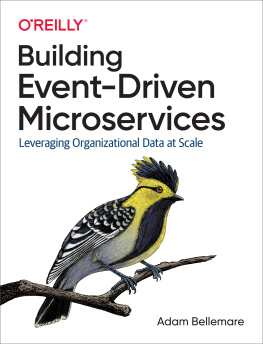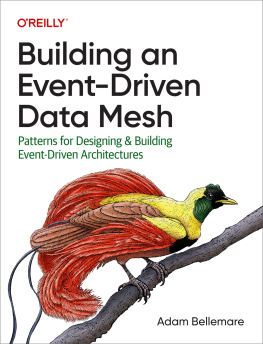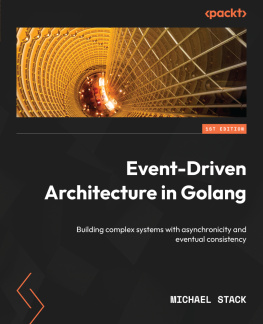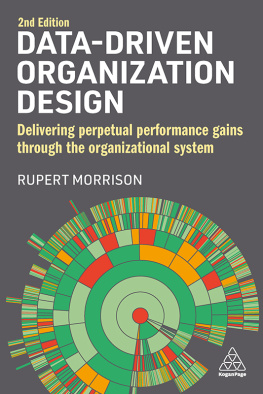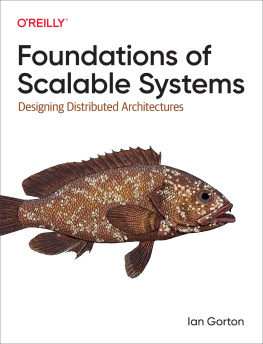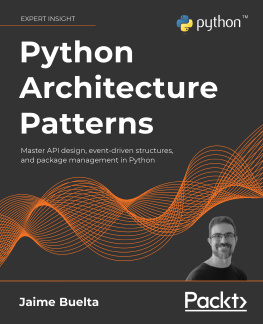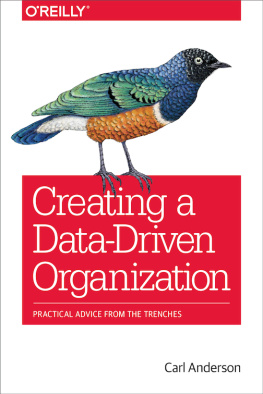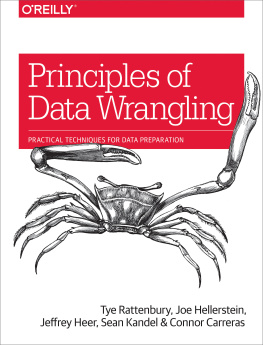Building Event-Driven Microservices
by Adam Bellemare
Copyright 2020 Adam Bellemare. All rights reserved.
Printed in the United States of America.
Published by OReilly Media, Inc. , 1005 Gravenstein Highway North, Sebastopol, CA 95472.
OReilly books may be purchased for educational, business, or sales promotional use. Online editions are also available for most titles (http://oreilly.com). For more information, contact our corporate/institutional sales department: 800-998-9938 or corporate@oreilly.com .
- Acquisitions Editor: Melissa Duffield
- Development Editor: Corbin Collins
- Production Editor: Christopher Faucher
- Copyeditor: Rachel Monaghan
- Proofreader: Kim Wimpsett
- Indexer: Potomac Indexing, LLC
- Interior Designer: David Futato
- Cover Designer: Karen Montgomery
- Illustrator: OReilly Media, Inc.
- August 2020: First Edition
Revision History for the First Edition
- 2020-07-02: First Release
See http://oreilly.com/catalog/errata.csp?isbn=9781492057895 for release details.
The OReilly logo is a registered trademark of OReilly Media, Inc. Building Event-Driven Microservices, the cover image, and related trade dress are trademarks of OReilly Media, Inc.
The views expressed in this work are those of the author, and do not represent the publishers views. While the publisher and the author have used good faith efforts to ensure that the information and instructions contained in this work are accurate, the publisher and the author disclaim all responsibility for errors or omissions, including without limitation responsibility for damages resulting from the use of or reliance on this work. Use of the information and instructions contained in this work is at your own risk. If any code samples or other technology this work contains or describes is subject to open source licenses or the intellectual property rights of others, it is your responsibility to ensure that your use thereof complies with such licenses and/or rights.
978-1-492-05789-5
[LSI]
Preface
I wrote this book to be the book that I wish Id had when I started out on my journey into the world of event-driven microservices. This book is a culmination of my own personal experiences, discussions with others, and the countless blogs, books, posts, talks, conferences, and documentation related to one part or another of the event-driven microservice world. I found that many of the works I read mentioned event-driven architectures either only in passing or with insufficient depth. Some covered only a specific aspect of the architecture and, while helpful, provided only a small piece of the puzzle. Other works proved to be reductive and dismissive, asserting that event-driven systems are really only useful for one system to send an asynchronous message directly to another as a replacement for synchronous request-response systems. As this book details, there is far more to event-driven architectures than this.
The tools that we use shape and influence our inventions significantly. Event-driven microservice architectures are made possible by a whole host of technologies that have only recently become readily accessible. Distributed, fault-tolerant, high-capacity, and high-speed event brokers underpin the architectures and design patterns in this book. These technological solutions are based on the convergence of big data with the need for near-real-time event processing. Microservices are facilitated by the ease of containerization and the requisitioning of compute resources, allowing for simplified hosting, scaling, and management of hundreds of thousands of microservices.
The technologies that support event-driven microservices have a significant impact on how we think about and solve problems, as well as on how our businesses and organizations are structured. Event-driven microservices change how a business works, how problems can be solved, and how teams, people, and business units communicate. These tools give you a truly new way of doing things that has not been possible until only recently.
Conventions Used in This Book
The following typographical conventions are used in this book:
ItalicIndicates new terms, URLs, email addresses, filenames, and file extensions.
Constant widthUsed for program listings, as well as within paragraphs to refer to program elements such as variable or function names, databases, data types, environment variables, statements, and keywords.
Constant width boldShows commands or other text that should be typed literally by the user.
Constant width italicShows text that should be replaced with user-supplied values or by values determined by context.
Tip
This element signifies a tip or suggestion.
Note
This element signifies a general note.
Warning
This element indicates a warning or caution.
OReilly Online Learning
Note
For more than 40 years, OReilly Media has provided technology and business training, knowledge, and insight to help companies succeed.
Our unique network of experts and innovators share their knowledge and expertise through books, articles, and our online learning platform. OReillys online learning platform gives you on-demand access to live training courses, in-depth learning paths, interactive coding environments, and a vast collection of text and video from OReilly and 200+ other publishers. For more information, visit http://oreilly.com.
How to Contact Us
Please address comments and questions concerning this book to the publisher:
- OReilly Media, Inc.
- 1005 Gravenstein Highway North
- Sebastopol, CA 95472
- 800-998-9938 (in the United States or Canada)
- 707-829-0515 (international or local)
- 707-829-0104 (fax)
We have a web page for this book, where we list errata, examples, and any additional information. You can access this page at https://oreil.ly/building-event-driven-microservices.
Email to comment or ask technical questions about this book.
For news and information about our books and courses, visit http://oreilly.com.
Find us on Facebook: http://facebook.com/oreilly
Follow us on Twitter: http://twitter.com/oreillymedia
Watch us on YouTube: http://youtube.com/oreillymedia
Acknowledgments
Id like to express my respect and gratitude for the people at Confluent, who, along with inventing Apache Kafka, are some of the first people who particularly get it when it comes to event-driven architectures. I have been fortunate enough to have one of their members, Ben Stopford (lead technologist, Office of the CTO), provide ample and valuable feedback. Scott Morrison, CTO of PHEMI Systems, has also provided me with valuable insights, feedback, and recommendations. I offer my thanks and gratitude to both Scott and Ben for helping make this book what it is today. As primary proofreaders and technical experts, they have helped me refine ideas, challenged me to improve the content quality, prevented me from promoting incorrect information, and helped me tell the story of event-driven architectures.
I would also like to extend my thanks to my friends Justin Tokarchuk, Gary Graham, and Nick Green, who proofread and edited a number of my drafts. Along with Scott and Ben, they helped me to identify the most significant weak points in my narrative, suggested ways to improve them, and provided their insights and personal experience in relation to the material.

